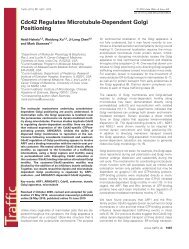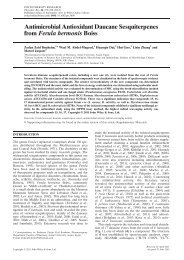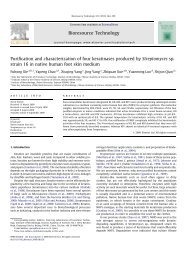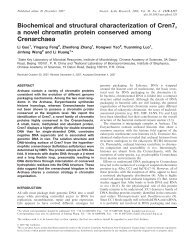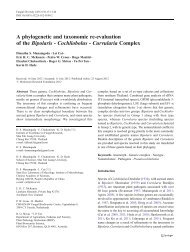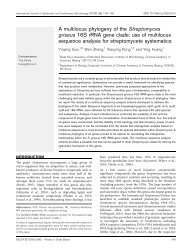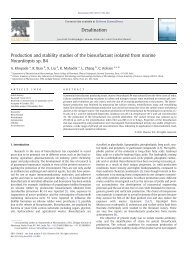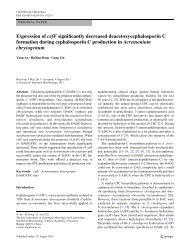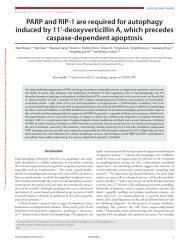Saturation mutagenesis of Acremonium chrysogenum deacetoxy ...
Saturation mutagenesis of Acremonium chrysogenum deacetoxy ...
Saturation mutagenesis of Acremonium chrysogenum deacetoxy ...
Create successful ePaper yourself
Turn your PDF publications into a flip-book with our unique Google optimized e-Paper software.
Biotechnol Lett<br />
DOI 10.1007/s10529-010-0504-5<br />
ORIGINAL RESEARCH PAPER<br />
<strong>Saturation</strong> <strong>mutagenesis</strong> <strong>of</strong> <strong>Acremonium</strong> <strong>chrysogenum</strong><br />
<strong>deacetoxy</strong>/deacetylcephalosporin C synthase R308 site<br />
confirms its role in controlling substrate specificity<br />
Xiao-Bin Wu • Xiu-Yun Tian • Jun-Jie Ji •<br />
Wei-Bin Wu • Ke-Qiang Fan • Ke-Qian Yang<br />
Received: 13 October 2010 / Accepted: 8 December 2010<br />
Ó Springer Science+Business Media B.V. 2010<br />
Abstract Deacetoxy/deacetylcephalosporin C synthase<br />
(acDAOC/DACS) from <strong>Acremonium</strong> <strong>chrysogenum</strong><br />
is a bifunctional enzyme that catalyzes both the<br />
ring-expansion <strong>of</strong> penicillin N to <strong>deacetoxy</strong>cephalosporin<br />
C and the hydroxylation <strong>of</strong> the latter to<br />
deacetylcephalosporin C. The R308 residue located<br />
in close proximity to the C-terminus <strong>of</strong> acDAOC/<br />
DACS was mutated to the other 19 amino acids. In<br />
the resulting mutant pool, R308L, R308I, R308T and<br />
R308V showed significant improvement in their<br />
ability to convert penicillin analogs, thus confirming<br />
the role <strong>of</strong> R308 in controlling substrate selectivity,<br />
the four amino acids all possess short aliphatic<br />
sidechains that may improve hydrophobic interactions<br />
with the substrates. The mutant R308I showed<br />
the highest reactivity for penicillin G, with 3-fold<br />
increase in k cat /K m ratio and 7-fold increase in<br />
relative activity.<br />
Xiao-Bin Wu and Xiu-Yun Tian contributed equally.<br />
X.-B. Wu X.-Y. Tian J.-J. Ji W.-B. Wu <br />
K.-Q. Fan K.-Q. Yang (&)<br />
State Key Laboratory <strong>of</strong> Microbial Resources, Institute<br />
<strong>of</strong> Microbiology, Chinese Academy <strong>of</strong> Sciences, No. 1<br />
West Beichen Road, Chaoyang District, Beijing 100101,<br />
People’s Republic <strong>of</strong> China<br />
e-mail: yangkq@im.ac.cn<br />
K.-Q. Fan<br />
National Key Laboratory <strong>of</strong> Biochemical Engineering,<br />
Institute <strong>of</strong> Process Engineering, Chinese Academy<br />
<strong>of</strong> Sciences, Beijing 100190, People’s Republic <strong>of</strong> China<br />
Keywords <strong>Acremonium</strong> <strong>chrysogenum</strong> <br />
C-terminus Expandase Kinetics Mutagenesis<br />
Introduction<br />
The ring-expansion <strong>of</strong> penicillin N to <strong>deacetoxy</strong>cephalosporin<br />
C (DAOC) is catalysed by a bifunctional<br />
enzyme <strong>deacetoxy</strong>/deacetylcephalosporin C<br />
synthase (DAOC/DACS) (Scheidegger et al. 1984),<br />
which also catalyzes hydroxylation <strong>of</strong> DAOC to<br />
deacetylcephalosporin C (DAC) (Samson et al.<br />
1987). Ring-expansion <strong>of</strong> penicillin G followed by<br />
enzymatic removal <strong>of</strong> its sidechain, or ring-expansion<br />
<strong>of</strong> 6-aminopenicillanic acid (6-APA) is promising<br />
bioprocess to produce 7-amino-3-<strong>deacetoxy</strong>cephalosporanic<br />
acid (7-ADCA), a key intermediate <strong>of</strong> semisynthetic<br />
cephalosporins (Velasco et al. 2000). This<br />
process demands an engineered DAOCS with altered<br />
substrate specificity and increased catalytic activity<br />
toward desired substrates. Streptomyces clavuligerus<br />
DAOCS (scDAOCS) was first recognized to possess<br />
broad substrate specificity (converts substrates<br />
besides penicillin N, such as penicillin G) (Cho et al.<br />
1998) and became the major target for research and<br />
engineering (Chin et al. 2004; Goo et al. 2008a, 2009;<br />
Hsu et al. 2004; Wei et al. 2003, 2005). However,<br />
DAOC/DACS <strong>of</strong> eukaryotic origin is also interesting<br />
in being bifunctional and more adapted in the<br />
industrial eukaryotic host.<br />
123
Biotechnol Lett<br />
Many mutants <strong>of</strong> scDAOCS show increased ringexpanding<br />
activity towards penicillin G, most mutations<br />
were found in a small barrel subdomain (Wei<br />
et al. 2003; 2005) or in loops near this subdomain<br />
(Hsu et al. 2004), especially in the C-terminal<br />
residues 304–307 (Chin et al. 2004; Chin and Sim<br />
2002; Goo et al. 2008a, b; Lee et al. 2001; Wei et al.<br />
2003). Studies <strong>of</strong> <strong>Acremonium</strong> <strong>chrysogenum</strong> DAOC/<br />
DACS (acDAOC/DACS) (Lloyd et al. 1999; Wu<br />
et al. 2005) also revealed the importance <strong>of</strong> its<br />
C-terminal residues N305, M306 and R308 (the<br />
equivalents <strong>of</strong> residues 304, 305 and 307 in<br />
scDAOCS) in substrate selectivity and/or catalytic<br />
activity. In our previous research, mutation <strong>of</strong><br />
acDAOC/DACS R308 (R308L) was found to significantly<br />
improve its activity to convert penicillin G<br />
(Wu et al. 2005). This was the first time that R308<br />
was identified as a critical residue for acDAOC/<br />
DACS activity. To further confirm its role, we<br />
prepared a saturation <strong>mutagenesis</strong> library <strong>of</strong> R308<br />
<strong>of</strong> acDAOC/DACS, and evaluated the enzyme activities<br />
<strong>of</strong> the ensuing mutants.<br />
Methods<br />
Site-directed <strong>mutagenesis</strong><br />
QuikChange site-directed <strong>mutagenesis</strong> kit (Stratagene)<br />
was used according to manufacturer’s instructions<br />
with pET-CE (Wu et al. 2005) as <strong>mutagenesis</strong><br />
template. All mutant constructions were verified by<br />
DNA sequencing.<br />
Expression and purification <strong>of</strong> WT and mutant<br />
DAOC/DACS<br />
The mutant enzymes were expressed and purified<br />
using similar methods as described by Wu et al.<br />
(2005) with minor modifications: the E. coli cultures<br />
were grown at 25°C and induced with 0.4 mM<br />
isopropyl IPTG. The expressed DAOC/DACS were<br />
purified using an ÄKTA fast protein liquid chromatography<br />
system at 4°C. Cell-free extracts were<br />
loaded onto a Resource Q anion-exchange column<br />
(6 ml) pre-equilibrated with 30 ml buffer A (50 mM<br />
MOPS), 1 mM EDTA and 1 mM dithiothreitol<br />
(DTT), pH 8.0). The column was washed with<br />
12 ml buffer A and the expandase was eluted with<br />
a 0–200 mM NaCl linear gradient at 0.5 ml min -1 .<br />
The enzyme fractions were collected and concentrated<br />
to 0.5 ml before loading onto a Superdex 75<br />
10/300 GL column (10 9 300 mm) and eluted with<br />
36 ml buffer M (50 mM MOPS and 1 mM DTT, pH<br />
7.4) at 0.5 ml min -1 . The active fractions were<br />
collected and concentrated into a final volume <strong>of</strong><br />
0.5 ml.<br />
Enzyme assays and bioassay <strong>of</strong> penicillin<br />
conversion<br />
The ring-expansion activities <strong>of</strong> DAOC/DACS on<br />
various penicillin analogs were assayed using the<br />
same methods as described by Wu et al. (2005). The<br />
bioassay <strong>of</strong> penicillin conversion used a procedure<br />
similar to that <strong>of</strong> Cho et al. (1998).<br />
Spectrophotometric assay <strong>of</strong> penicillin conversion<br />
A spectrophotometric method similar to that reported<br />
previously by Baldwin and Crabbe (1987) was used.<br />
The reactions were performed at the same conditions<br />
as for bioassays. Relative specific activities for<br />
mutated enzymes were calculated as the ratio <strong>of</strong><br />
absorbance at 260 nm <strong>of</strong> mutant to that <strong>of</strong> WT<br />
enzyme.<br />
HPLC analyses<br />
A Phenomenex C18 column (3.9 9 300 mm) was<br />
used. Separation was performed with conditions<br />
similar to those <strong>of</strong> Chin and Sim (2002). Detection<br />
was simultaneously at 220 and 260 nm. The retention<br />
times <strong>of</strong> G-7-ADCA and penicillin G were 22.6 and<br />
23.5 min, respectively.<br />
Kinetic analyses<br />
Kinetic parameters <strong>of</strong> purified wild type (WT) and<br />
mutated enzymes for penicillin G conversion were<br />
determined using similar procedures as described for<br />
enzyme assay except the reaction time was 30 min.<br />
Penicillin G was used from 1 to 10 mM, while the<br />
amount <strong>of</strong> the enzyme was kept constant at<br />
0.7 mg ml -1 . The kinetic parameters were calculated<br />
via non-linear curve fit by Origin 6.1.<br />
123
Biotechnol Lett<br />
Results<br />
Mutation and expression <strong>of</strong> WT and mutant<br />
acDAOC/DACS<br />
R308 was identified as a critical residue for acDAOC/<br />
DACS activity (Wu et al. 2005). The R308L mutant<br />
showed 4.3-fold increase in its specific activity to<br />
penicillin G. Close examination <strong>of</strong> the comparative<br />
model <strong>of</strong> acDAOC/DACS and the position <strong>of</strong> R308<br />
relative to the catalytic center led to the proposal that<br />
R308 controls substrate entry and product release<br />
(Wu et al. 2005).<br />
The expressed WT and mutant acDAOC/DACS<br />
were isolated as cell-free extracts and analyzed by<br />
SDS-PAGE (data not shown). All mutant acDAOC/<br />
DACS were obtained at high levels as soluble<br />
proteins (*30% <strong>of</strong> total soluble protein) as judged<br />
by SDS-PAGE. The enzymes were purified using<br />
Resource Q and Superdex 75 column to[90% purity<br />
(data not shown). The concentrations <strong>of</strong> each purified<br />
protein were about 2–3 mg ml -1 as determined by<br />
Bradford assay.<br />
Penicillin analogs conversion measured<br />
by bioassay and spectrophotometric assay<br />
The relative specific activities <strong>of</strong> purified enzymes in<br />
the conversion <strong>of</strong> various penicillin analogs were<br />
determined by bioassay (Table 1). The mutants<br />
R308L, R308I, R308T and R308V showed significantly<br />
enhanced activity to convert penicillin analogs<br />
compared to the WT enzyme. Among all tested<br />
mutants, R308L and R308I showed the most significant<br />
improvement <strong>of</strong> about 520 and 760%, respectively,<br />
for penicillin G conversion. Noticeably,<br />
R308L and R308I also showed the broadest substrate<br />
specificity and the most improved catalytic activity,<br />
being able to convert all penicillin analogs tested.<br />
Additionally, all other mutants showed similar<br />
percent conversion <strong>of</strong> 6-APA as the WT enzyme<br />
(Table 1b), but no detectable conversion <strong>of</strong> other<br />
penicillin analogs was observed.<br />
Due to the intrinsic differences in diffusion factors<br />
and antibiotic activities <strong>of</strong> different ring expansion<br />
products, the bioassay results must be judged with<br />
caution (Shibata et al. 1996). Thus a more sensitive<br />
Table 1 Relative specific activities <strong>of</strong> WT and mutated acDAOC/DACS on (a) penicillin analogs conversion and (b) 6-APA<br />
conversion determined by bioassay<br />
(a)<br />
WT R308T R308I R308V R308L<br />
Penicillin G 100 346 762 391 516<br />
Carbenicillin 100 NC 194 NC 194<br />
Ampicillin 100 NC 396 NC 311<br />
6-APA 100 126 127 90 100<br />
Penicillin V 100 NC NC NC 170<br />
Amoxicillin NC NC NC NC 100<br />
(b)<br />
WT R308A R308N R308D R308C R308Q R308E R308H<br />
6-APA 100 127 75 88 100 75 75 114<br />
R308K R308M R308F R308P R308S R308G R308W R308Y<br />
114 101 127 53 75 105 84 43<br />
The activities for wild type acDAOC/DACS were 55, 52, 60.5, 31.5, 80, 61 nmol product/min.mg protein toward penicillin G,<br />
carbenicillin, ampicillin, 6-APA, penicillin V and amoxicillin, respectively (each penicillin analog was provided at 10 mM in assay<br />
mixture). The results shown in this table were averages calculated from at least five independent bioassay experiments. NC no<br />
conversion observed<br />
123
Biotechnol Lett<br />
spectrophotometric method (Baldwin and Crabbe<br />
1987) was used to verify the bioassay results. The<br />
spectrophotometric data are listed in Table 2. In the<br />
spectrophotometric assay, all mutants and WT ac-<br />
DAOC/DACS exhibited broader conversion spectrum<br />
to penicillin analogs, due to higher sensitivity <strong>of</strong> the<br />
method; however, the absolute conversion <strong>of</strong> ampicillin,<br />
amoxicillin, carbenicillin and penicillin V were<br />
very low. Overall, the percent conversions determined<br />
by spectrophotometric assay showed similar<br />
trend as those obtained by bioassay, confirming the<br />
significant enhanced activities <strong>of</strong> R308L, R308I,<br />
R308T and R308V relative to the WT enzyme.<br />
Kinetics analysis <strong>of</strong> mutant acDAOC/DACS<br />
Apparent kinetic parameters <strong>of</strong> purified WT enzyme,<br />
R308L and R308I mutants were determined by HPLC<br />
using penicillin G as substrate (Table 3). The mutants<br />
showed significantly increased k cat (12-fold for R308I<br />
and 8.4-fold for R308L, respectively) and K m (4.2-<br />
fold and 5.5-fold, respectively) relative to those <strong>of</strong><br />
Table 2 Relative specific activities <strong>of</strong> WT and mutant acDAOC/DACS on penicillin analog conversion determined by spectrophotometric<br />
assay<br />
Ampicillin Amoxicillin 6-APA Carbenicillin Penicillin G Penicillin V<br />
WT 100 100 100 100 100 100<br />
R308L 231 267 130 119 458 222<br />
R308I 276 192 151 124 739 199<br />
R308T 124 170 109 102 374 111<br />
R308V 114 228 101 111 380 122<br />
R308A 111 187 140 95 173 118<br />
R308N 101 111 82 88 151 135<br />
R308D 112 129 123 111 138 177<br />
R308C 112 127 113 113 158 187<br />
R308Q 112 114 122 115 167 160<br />
R308E 61 106 129 108 160 194<br />
R308G 101 116 126 112 113 191<br />
R308H 150 130 110 102 128 135<br />
R308K 78 105 99 101 118 177<br />
R308M 78 127 121 110 140 191<br />
R308F 111 110 99 19 110 184<br />
R308P 106 126 118 110 158 160<br />
R308S 75 168 132 117 103 180<br />
R308W 142 116 128 114 158 177<br />
R308Y 89 118 141 115 122 180<br />
The activities for wild type acDAOC/DACS were 55, 52, 60.5, 31.5, 80, 61 nmol product/min.mg protein toward penicillin G,<br />
carbenicillin, ampicillin, 6-APA, penicillin V and amoxicillin, respectively (each penicillin analog was provided at 10 mM in assay<br />
mixture). The results shown in this table were averages calculated from at least five independent experiments<br />
Table 3 Kinetic parameters for penicillin G conversion by WT and mutated acDAOC/DACS determined via HPLC<br />
Enzymes k cat (s -1 ) K m (mM) k cat /K m (s -1 M -1 ) Relative% k cat /K m<br />
Wild-type 0.0057 ± 0.0005 1.9 ± 0.4 3 100<br />
R308I 0.069 ± 0.013 8.2 ± 2.6 8.5 287<br />
R308L 0.048 ± 0.005 11 ± 2 4.5 152<br />
All kinetic parameters shown were the average values ± standard errors determined via non-linear curve fit<br />
123
Biotechnol Lett<br />
WT enzyme. As a result, the k cat /K m for the ringexpansion<br />
<strong>of</strong> penicillin G by the R308I mutant<br />
improved over that <strong>of</strong> the WT enzyme by about 2.9-<br />
fold.<br />
Discussion<br />
7-ADCA is the starting material for many semisynthetic<br />
cephalosporin antibiotics. A direct fermentation<br />
process for G-7-ADCA followed by enzymatic<br />
removal <strong>of</strong> its sidechain is a promising strategy to<br />
produce 7-ADCA (Velasco et al. 2000). This process<br />
demands an engineered DAOCS with altered substrate<br />
specificity to convert penicillin G.<br />
Although the structure <strong>of</strong> acDAOC/DACS is not<br />
yet available, but since it shows 57% sequence<br />
identity to scDAOCS and the major difference<br />
between the two enzymes is that acDAOC/DACS<br />
has 20 extra residues at its C-terminus, which was<br />
shown to have little effect on its enzyme activity<br />
(Lloyd et al. 1999), we were able to construct a<br />
reliable structural model <strong>of</strong> acDAOCS/DACS using<br />
scDAOCS as template. Most <strong>of</strong> the key residues for<br />
penicillin G binding in scDAOCS catalytic center<br />
were conserved in acDAOC/DACS (Goo et al. 2009).<br />
Many residues not in the catalytic center were also<br />
conserved in both enzymes, this includes the C-<br />
terminal R308 (R307 in scDAOCS). The crystal<br />
structures <strong>of</strong> scDAOCS in complex with the substrate<br />
penicillin G and ampicillin have been determined by<br />
two groups (Valegård et al. 2004; Öster et al. 2004).<br />
As shown by the crystal structure <strong>of</strong> the scDAOCSpenicillin<br />
G complex (PDB code: 1UOB), R307 was<br />
on the surface <strong>of</strong> the enzyme and was far from<br />
penicillin G (above 9.8 Å). So it is obvious that<br />
scDAOCS R307 is not located in the catalytic center,<br />
but scDAOCS R307L mutant showed slightly<br />
increased activity for penicillin G (124%) and significantly<br />
increased activity for penicillin V (329%)<br />
(Chin et al. 2002). The crystal structure <strong>of</strong> scDAOCS<br />
revealed that R307 resides on the edge <strong>of</strong> substratebinding<br />
pocket, we speculate that R307 might control<br />
the rates <strong>of</strong> substrate entry and/or product release.<br />
A structural model <strong>of</strong> acDAOC/DACS with penicillin<br />
G was constructed with reasonable confidence<br />
by SWISS-MODEL web server (http://swissmodel.<br />
expasy.org/) and reported in our previous study (Wu<br />
et al. 2005). The comparative model (Fig. 1) indicated<br />
that R308 is one <strong>of</strong> the few residues predicted<br />
to point toward the substrate-product path and might<br />
play the same role as its counterpart R307 in<br />
Fig. 1 3D-structure <strong>of</strong> the modeled substrate binding region <strong>of</strong><br />
acDAOC/DACS in complex with penicillin G The ferrous ion<br />
was displayed as an orange ball. Penicillin G was orientated so<br />
its tetrahydrothiazole ring points upward. The C-terminal<br />
residues 300–309 are in green. Mutated residue R308 is in deep<br />
pink and labeled with purple numbers. Side-chains <strong>of</strong> C-<br />
terminus N305, M306 and R308 point toward the substrate are<br />
predicted to influence substrate binding and catalysis; in<br />
contrast, R307 extending out <strong>of</strong> the substrate-binding site<br />
should have minimal effect on enzyme activity<br />
123
Biotechnol Lett<br />
scDAOCS in controlling substrate entry and/or<br />
product release. This prediction is supported by the<br />
activity pr<strong>of</strong>iles <strong>of</strong> the mutants in this study. Among<br />
the 19 R308 mutants, R308L, R308V, R308I and<br />
R308T showed 3.46- to 7.62-times increased specific<br />
activity for penicillin G. The four mutated amino<br />
acids (leucine, valine, isoleucine and threonine) have<br />
similar short aliphatic sidechains; unlike the positivecharged<br />
guanidine containing arginine (Fig. 2).<br />
Another R308 mutation to aliphatic alanine (R308A)<br />
also increased the activity <strong>of</strong> mutant to convert<br />
6-APA, penicillin G and amoxicillin as determined<br />
by spectrophotometric assay. These results confirm<br />
the important role <strong>of</strong> R308 in substrate pathway<br />
control and suggest that the decreased polarity at this<br />
position would be beneficial for penicillin G selection.<br />
Fig. 2 Structures <strong>of</strong> the<br />
WT and mutated amino<br />
acids at position 308<br />
Fig. 3 Chemical structures<br />
<strong>of</strong> penicillin analogs<br />
123
Biotechnol Lett<br />
Mutations to polar or charged residues generated<br />
enzymes with activities similar to WT enzyme.<br />
Although large aromatic amino acids, such as phenylalanine<br />
and tyrosine, may interact well with the side<br />
chain <strong>of</strong> penicillin G, mutations to these amino acids<br />
did not generate improved enzymes (Table 2). This<br />
maybe due to spacial hindrance caused by their bulky<br />
side chains, which could impede substrate entry or<br />
product release. Taken together, we conclude that<br />
R308 is a critical residue for substrate selection, both<br />
side chain polarity and size at this position will<br />
influence final enzyme activity.<br />
Among six penicillin analogs tested (Fig. 3),<br />
penicillin G has the least sidechain polarity, followed<br />
by penicillin V which had a phenoxymethyl sidechain.<br />
Other analogs, such as ampicillin, amoxicillin<br />
and carbenicillin, have charged amino or carboxyl<br />
groups. 6-APA has no sidechain, but an amino group.<br />
It is notable that the four hydrophobic mutants <strong>of</strong><br />
R308 increased the catalytic activity <strong>of</strong> the enzyme to<br />
phenyl-containing penicillin analogs, but had little<br />
effect on 6-APA, again suggesting the interaction<br />
between the substrate and the enzyme is determined<br />
by both polarity and size <strong>of</strong> the substrate-product<br />
path.<br />
The apparent kinetic parameters <strong>of</strong> WT acDAOC/<br />
DACS, R308I and R308L were determined via nonlinear<br />
curve fit; both mutants showed significantly<br />
increased k cat and K m (Table 3). These mutations<br />
<strong>of</strong>fered appropriate polarity and size for penicillin G<br />
selection, and may facilitate substrate entry and/or<br />
product release. The large increment in k cat is the<br />
direct result <strong>of</strong> accelerated product release, while K m<br />
increase maybe the result <strong>of</strong> altered substrate entry<br />
rate and secondary conformational changes induced<br />
by R308 mutations, since although R308 is far from<br />
substrate binding pocket (about 11 Å), it is close to<br />
the ferrous ligand H184 (about 5 Å) and two other<br />
key residues M181 and M306 in the substrate binding<br />
pocket (about 8 and 7 Å, respectively). The overall<br />
result is that improved k cat is compromised by<br />
simultaneously increased K m .<br />
Acknowledgments We wish to thank Pr<strong>of</strong>essor A. L. Demain<br />
for kindly providing E. coli Ess strain. This work was supported<br />
by the Ministry <strong>of</strong> Science and Technology <strong>of</strong> China (Grant<br />
2007BAI26B02), the Knowledge Innovation Fund (Grant<br />
KSCX2-YW-G-018) from Chinese Academy <strong>of</strong> Sciences and<br />
the Open Funding Project <strong>of</strong> the National Key Laboratory <strong>of</strong><br />
Biochemical Engineering (Grant KF-001).<br />
References<br />
Baldwin JE, Crabbe MJ (1987) A spectrophotometric assay<br />
for <strong>deacetoxy</strong>cephalosporin C synthase. FEBS Lett 214:<br />
357–361<br />
Chin HS, Sim TS (2002) C-terminus modification <strong>of</strong> Streptomyces<br />
clavuligerus <strong>deacetoxy</strong>cephalosporin C synthase<br />
improves catalysis with an expanded substrate specificity.<br />
Biochem Biophys Res Commun 295:55–61<br />
Chin HS, Goo KS, Sim TS (2004) A complete library <strong>of</strong> amino<br />
acid alterations at N304 in Streptomyces clavuligerus<br />
<strong>deacetoxy</strong>cephalosporin C synthase elucidates the basis<br />
for enhanced penicillin analogue conversion. Appl Environ<br />
Microbiol 70:607–609<br />
Cho H, Adrio JL, Luengo JM, Wolfe S, Ocran S, Hintermann<br />
G, Piret JM, Demain AL (1998) Elucidation <strong>of</strong> conditions<br />
allowing conversion <strong>of</strong> penicillin G and other penicillins<br />
to <strong>deacetoxy</strong>cephalosporins by resting cells and extracts<br />
<strong>of</strong> Streptomyces clavuligerus NP1. Proc Natl Acad Sci<br />
USA 95:11544–11548<br />
Goo KS, Chua CS, Sim TS (2008a) A complete library <strong>of</strong><br />
amino acid alterations at R306 in Streptomyces clavuligerus<br />
<strong>deacetoxy</strong>cephalosporin C synthase demonstrates<br />
its structural role in the ring-expansion activity. Proteins<br />
70:739–747<br />
Goo KS, Chua CS, Sim TS (2008b) Relevant double mutations<br />
in bioengineered Streptomyces clavuligerus <strong>deacetoxy</strong>cephalosporin<br />
C synthase result in higher binding specificities<br />
which improve penicillin bioconversion. Appl<br />
Environ Microbiol 74:1167–1175<br />
Goo KS, Chua CS, Sim TS (2009) Directed evolution and<br />
rational approaches to improving Streptomyces clavuligerus<br />
<strong>deacetoxy</strong>cephalosporin C synthase for cephalosporin<br />
production. J Ind Microbiol Biotechnol 36:619–633<br />
Hsu JS, Yang YB, Deng CH, Wei CL, Liaw SH, Tsai YC<br />
(2004) Family shuffling <strong>of</strong> expandase genes to enhance<br />
substrate specificity for penicillin G. Appl Environ<br />
Microbiol 70:6257–6263<br />
Lee HJ, Lloyd MD, Harlos K, Clifton IJ, Baldwin JE, Sch<strong>of</strong>ield<br />
CJ (2001) Kinetic and crystallographic studies on <strong>deacetoxy</strong>cephalosporin<br />
C synthase (DAOCS). J Mol Biol<br />
308:937–948<br />
Lipscomb SJ, Lee HJ, Mukherji M, Baldwin JE, Sch<strong>of</strong>ield CJ,<br />
Lloyd MD (2002) The role <strong>of</strong> arginine residues in substrate<br />
binding and catalysis by <strong>deacetoxy</strong>cephalosporin C<br />
synthase. Eur J Biochem 269:2735–2739<br />
Lloyd MD, Lee HJ, Harlos K, Zhang ZH, Baldwin JE, Sch<strong>of</strong>ield<br />
CJ, Charnock JM, Garner CD, Hara T, Terwisscha<br />
van Scheltinga AC, Valegård K, Viklund JA, Hajdu J,<br />
Andersson I, Danielsson A, Bhikhabhai R (1999) Studies<br />
on the active site <strong>of</strong> <strong>deacetoxy</strong>cephalosporin C synthase.<br />
J Mol Biol 287:943–960<br />
Öster LM, Terwisscha van Scheltinga AC, Valegård K, Hose<br />
AM, Dubus A, Hajdu J, Andersson I (2004) Conformational<br />
flexibility <strong>of</strong> the C terminus with implications for<br />
substrate binding and catalysis revealed in a new crystal<br />
form <strong>of</strong> <strong>deacetoxy</strong>cephalosporin C synthase. J Mol Biol<br />
343:157–171<br />
Samson SM, Dotzlaf JE, Slisz ML, Becker GW, van Frank<br />
RM, Veal LE, Yeh WK, Miller JR, Queener SW, Ingolia<br />
123
Biotechnol Lett<br />
TD (1987) Cloning and expression <strong>of</strong> the fungal expandase/hydroxylase<br />
gene involved in cephalosporin biosynthesis.<br />
Nat Biotechnol 5:1207–1214<br />
Scheidegger A, Küenzi MT, Nüesch J (1984) Partial purification<br />
and catalytic properties <strong>of</strong> a bifunctional enzyme in<br />
the biosynthetic pathway <strong>of</strong> b-lactams in Cephalosporium<br />
acremonium. J Antibiot (Tokyo) 37:522–531<br />
Shibata N, Lloyd MD, Baldwin JE, Sch<strong>of</strong>ield CJ (1996) Adipoyl-6-aminopencillianic<br />
acid is a substrate for <strong>deacetoxy</strong>cephalosporin<br />
C synthase (DAOCS). Bioorg Med<br />
Chem Lett 6:1579–1584<br />
Valegård K, Terwisscha van Scheltinga AC, Dubus A,<br />
Ranghino G, Öster LM, Hajdu J, Andersson I (2004) The<br />
structural basis <strong>of</strong> cephalosporin formation in a mononuclear<br />
ferrous enzyme. Nat Struct Mol Biol 11:95–101<br />
Velasco J, Luis AJ, Angel MM, Díez B, Soler G, Barredo JL<br />
(2000) Environmentally safe production <strong>of</strong> 7-amino<strong>deacetoxy</strong>cephalosporanic<br />
acid (7-ADCA) using recombinant<br />
strains <strong>of</strong> <strong>Acremonium</strong> <strong>chrysogenum</strong>. Nat Biotechnol<br />
18:857–861<br />
Wei CL, Yang YB, Wang WC, Liu WC, Hsu JS, Tsai YC<br />
(2003) Engineering Streptomyces clavuligerus <strong>deacetoxy</strong>cephalosporin<br />
C synthase for optimal ring expansion<br />
activity toward penicillin G. Appl Environ Microbiol<br />
69:2306–2312<br />
Wei CL, Yang YB, Deng CH, Liu WC, Hsu JS, Lin YC,<br />
Liaw SH, Tsai YC (2005) Directed evolution <strong>of</strong> Streptomyces<br />
clavuligerus <strong>deacetoxy</strong>cephalosporin C synthase<br />
for enhancement <strong>of</strong> penicillin G expansion. Appl Environ<br />
Microbiol 71:8873–8880<br />
Wu XB, Fan KQ, Wang QH, Yang KQ (2005) C-terminus<br />
mutations <strong>of</strong> <strong>Acremonium</strong> <strong>chrysogenum</strong> <strong>deacetoxy</strong>/deacetylcephalosporin<br />
C synthase with improved activity<br />
toward penicillin analogs. FEMS Microbiol Lett 246:<br />
103–110<br />
123





